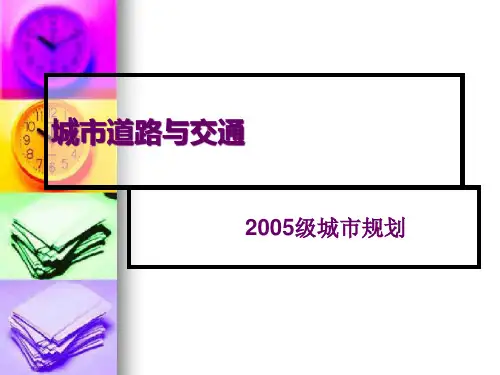同济大学 道路规划与几何设计课件 1绪论
- 格式:ppt
- 大小:32.89 MB
- 文档页数:76
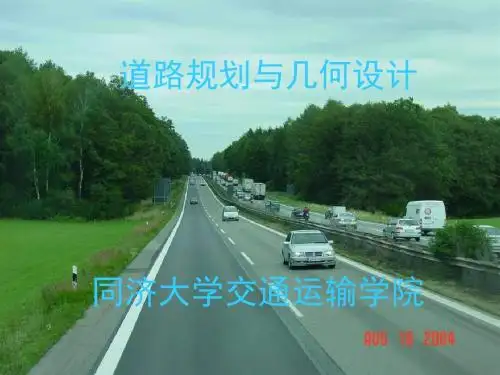
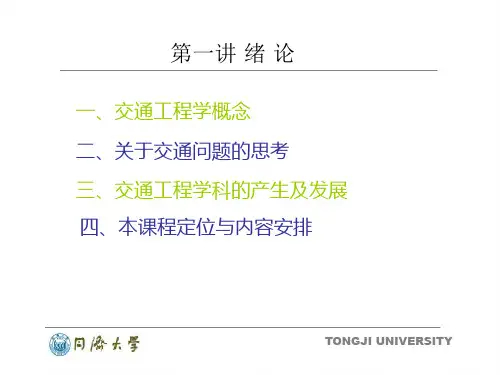
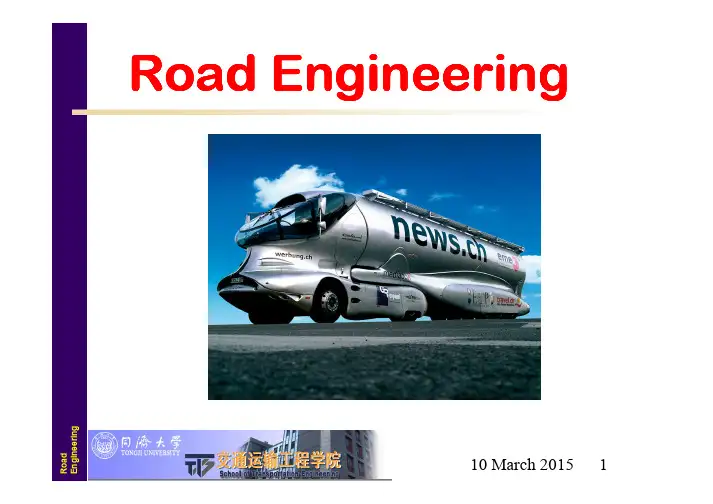
dneeringRoad Engineeringdn e e r i n gChapter 1:IntroductionRoad EngineeringHuizhao Tud ne e r i n gBackgroundd ne e r i n gNational Bureau of Statistics 2013Year0.020.040.060.080.020002001200220032004200520062007200820092010201120123.74.76.28.510.713.818.223.228.838.149.962.476.4Car ownership (private cars, Million)5 S e p . 2014BeijingShangha iGuangzho uBackgrounddn e e r i n gBackground上海内环双向四车道上海内环双向四车道??中外环双向八车道中外环双向八车道?? 为什么道路转弯有超高为什么道路转弯有超高?? 为什么城市快速路限速80km/h ? 为什么五角场环岛有信号控制?Road EngineeringHuizhao Tudn e e r i n g什么是道路工程什么是道路工程??百度名片•从事道路的规划规划、、勘测勘测、、设计设计、、施工施工、、养护等的一门应用科学和技术一门应用科学和技术,,是土木工程的一个分支(Source:百度百科)Road EngineeringHuizhao Tud ne e r i n gIntroduction•Huizhao Tu ( 涂辉招)–Email: huizhaotu@ –Tel:6958 0417–Room A619, School of Transportation Engineering –公邮:•roadengbp@ •201501bpdne er i n gIntroductiondn e e r i n gIntroduction•上海拍牌最低7万6千5(2015年2月)?•校车事件校车事件??•拥挤收费拥挤收费??d ne e r i n gWhy in English•好好学习好好学习,,天天向上–Good Good Study, Day Day up–Study hard, make the progress everyday!•科学发展观–Scientific Development?–Sustainable Development!!d ne e r i n gWhy in English•安全岛–Safe islands –Refuge islands•Capacity–容量–通行能力d ne e r i n gIntroductionRoadChapter 4: Transport Planning Chapter 5: Geometric Design Chapter 6: Intersection DesignChapter 7: Road Materials Chapter 8: Structure Design Chapter 9: Drainage DesignVehicleChapter 2: Vehicle PerformancePeopleChapter 10: Road ConstructionChapter 11: Road Safety & Environment Chapter 12: Infrastructure ManagementChapter 3: Traffic Flow Theoryd ne e r i n gIntroduction Introduction ----Transport System1.Rail2.Road3.Water4.Air5.Pipelined ne e r i n gMode 方式Power 动力Time 时间Space 距离cost per unit 单位成本Rail Internal combustion Electric powerSteam engine long long low RoadFuel Electric power short/long short middle WaterFuel Electric power long long low AirFuelshort long high Pipel ine TopographyPressure differencelonglonglowIntroduction Introduction ----Transport Systemd ne e r i n g•Road Traffic•Road Classifications •Components of Roads •Facts of RoadsIntroductiond ne e r i n gRoad Trafficdn e e r i n gRoad Traffic --elements1.Carrier (运载工具运载工具))2.Road3.Transport hub(枢纽枢纽))4.Traffic control & management 5.Infrastructure managementd ne e r i n gRoad Traffic --Advantages•Door-to-door:–Convenience (便捷性便捷性))•Geometric constraints–Accessibility (通达/可达性可达性))•Passengers & goods --short distance •Valuable goods --middle distanced ne e r i n gRoad Traffic --Disadvantages•Traffic congestions •Low loading capacity •High cost•High fuel consumption •Low reliability •Low safetydneeringRoad Traffic --Traffic congestionsdn e e r i n gRoad Traffic --Traffic congestionsdn e e r i n g Road Traffic --Traffic congestions •Physical bottleneck Xiamen 2007 Jan. 4dn e e r i n gRoad Traffic --Traffic congestions •Traffic incidentsdn e e r i n g Road Traffic --Traffic congestions •Bad Weather Traffic demand ±5% Capacity -15%~20%dn e e r i n g Road Traffic --Traffic congestions •Work Zonesdn e e r i n gRoad Traffic --Traffic congestions •Poor signal timingdn e e r i n g Road Traffic --Traffic congestions •Special Events/Othersdn e e r i n g Road Traffic --Traffic congestions •More of the system •More time of the day•Extra travel time penaltydn e e r i n g Road Traffic --Traffic congestionsdn e e r i n g Road Traffic --Reliability 30d ne e r i n gRoad Classificationsd ne e r i n gd ne e r i n gFactors considered in classification•Adjacent Land Use:–Urban vs. rural classification•Service Function:–Access to land. Ex: local–Service to traffic. Ex: freeways –both•Traffic Volume:–Freeways: high volume–Collectors and locals: low volume•Flow Characteristics:–Freeways: uninterrupted facility (连续流连续流))–Locals interrupted facility (间断流间断流))d ne e r i n gFactors considered in classification•Running Speed:–Generally increase from locals to collectors to arterials to freeways•Vehicle Type:–Proportion of passenger cars, buses, large trucks•Connections:–Normal for roads to connect to the same classification or one higher or one lowerd ne e r i n gRoad Classifications•Freeway or Motorway (高速路)–No plain crossing; With median barrier•Arterial road (主干道)–Backbone•Collector-distributor road (集散道路)•By-pass/local (地方道路)d ne e r i n gRoad Classifications36HighwayUrban RoadsUrban RoadsMinistry of TransportMinistry of Housing and Urban-Rual Developmentd ne e r i n gRoad Classifications•Differences–On-/off ramp metering –Travel speed–Traffic demand & Level of Service –Design periodd ne e r i n gRoad Classifications•Highways: Page 4, Table 1-5•Urban roads: Page 4, Table 1-6Classification Freeways Class 1Class 2Class 3Cla ss 4Designed speed (km/h)1201008010080608060403020d ne e r i n gRoad Componentsdn e e r i n gRoad Components•Road alignment (路线路线))•Road structure (结构物结构物))•Auxiliary facilities (附属设施附属设施))d ne e r i n gRoad Components--Alignment•Cross section (横断面横断面))•Page 5, Figure 1-1•Ditch:排水渠•Foreslope: 前边坡•Traveled way:行车道•Shoulder:路肩dn e e r i n gRoad Components--Alignment•Horizontal alignment (平面平面))–Tangent (直线直线))–Circular curve (圆曲线圆曲线))–Clothoid (回旋曲线回旋曲线))d ne e r i n gRoad Components--Alignment•Vertical alignment (纵断面纵断面))–Transition between two grades–Vertical curvesG 1G 2Crest Vertical CurveG 1G 2Sag Vertical Curvedn e e r i n gRoad Components--Alignment•Intersection–Plain intersection –(平面交叉平面交叉))–Interchange –(立体交叉立体交叉))d ne e r i n gRoad Components--StructureSurface course Binder courseAsphalt base course Road base courseSub-base Subgrade•Surface course:面层•Binder course:结合料层•Asphalt base course:沥青底层•Road base course:路基•Sub-base:垫层•Subgrade:地基/路床dn e e r i n gRoad Components--Structure•Culvert–(涵洞涵洞))•Bridge •Tunnel •Drainagedn e e r i n gRoad Components--Auxiliary facility•Traffic safety facility–Barrier; Anti-glare hurdle; Reflective marking;–护栏护栏;;防眩板防眩板;;反光标志•Traffic management–Signal; marking; marking line;VMS;E-phone•Parking–Stop; parking lots•Illumination (照明照明))dn e e r i n gRoad Components--Auxiliary facility•Sound panel (声屏障声屏障))•Service area (服务区服务区))•Toll gate/station (收费口/收费站收费站))•Landscaping/greening (绿化等绿化等))d ne e r i n gFacts of Roadsd ne e r i n gFacts of RoadsChinaUSAJapanGermanyFatal-accident (10k)20.440.77020.6600Car-ownership (10k)44002360070004800Fatal-rate(person/10k veh )46.431.71.11.37Year: 2009Sources: Chinese Year Book 2010。
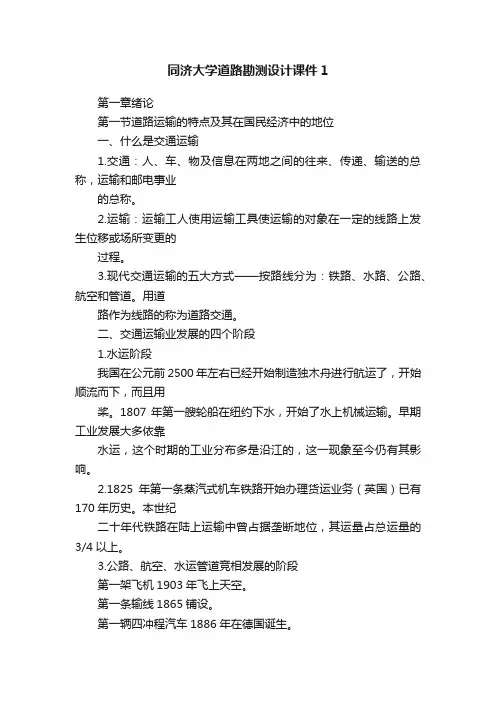
同济大学道路勘测设计课件1第一章绪论第一节道路运输的特点及其在国民经济中的地位一、什么是交通运输1.交通:人、车、物及信息在两地之间的往来、传递、输送的总称,运输和邮电事业的总称。
2.运输:运输工人使用运输工具使运输的对象在一定的线路上发生位移或场所变更的过程。
3.现代交通运输的五大方式——按路线分为:铁路、水路、公路、航空和管道。
用道路作为线路的称为道路交通。
二、交通运输业发展的四个阶段1.水运阶段我国在公元前2500年左右已经开始制造独木舟进行航运了,开始顺流而下,而且用桨。
1807年第一艘轮船在纽约下水,开始了水上机械运输。
早期工业发展大多依靠水运,这个时期的工业分布多是沿江的,这一现象至今仍有其影响。
2.1825年第一条蒸汽式机车铁路开始办理货运业务(英国)已有170年历史。
本世纪二十年代铁路在陆上运输中曾占据垄断地位,其运量占总运量的3/4以上。
3.公路、航空、水运管道竞相发展的阶段第一架飞机1903年飞上天空。
第一条输线1865铺设。
第一辆四冲程汽车1886年在德国诞生。
本世纪30年代以来道路运输突飞猛进的发展:①全世界汽车超过6亿量,其中小汽车3.4亿,货车0.63亿,美国1.35亿。
(Thecontry on wheels)②全世界交通网中公路路线长度占2/3。
③公路运输完成的客货运量占80%。
英、法、德的汽车是陆上运输的主力。
高速公路的发展使长途运输大大发展。
目前,道路运输向“高速度、大吨位、远距离、柴油机化、集装箱化、调度指挥电子化”的方向发展。
第四阶段是4.建立综合运输体系的阶段公路公路发展历史:1949年:8.1万Km1960年:51万Km(42.9/10年)1978年:88万Km(37/18年)1992年:104万Km(16/14年)其中:高速公路570Km一、二级汽专3000Km一般二级42000Km其他 28万Km1994年:107.5万Km(3.5/2年)其中:高速公路1145Km一、二级汽专7383Km二级以上7%1995年:111.78万Km(3.44/1年)其中:高速公路1603Km一、二级汽专9174Km1996年:118.58万Km(3.44/1年)其中:高速公路3422Km一级11779Km二级96990Km1997年: {121.4万Km其中:高速公路4735Km一、二级汽专新增3300Km}见另外资料。

